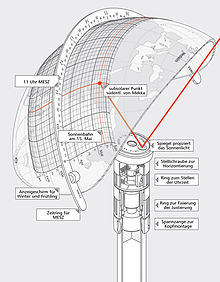Helios sundial
The Helios sundial is a modern globe sundial . The sun is depicted from behind on a globe segment . The light point shows the time of day and the season . It can also be interpreted as a subsolar point .
Working principle
The concave mirror built into the Helios sundial reflects the sunlight. It is also the imaging point ( Nodus ). The image of the sun disk appears as a point of light from behind on the screen ( dial ) of the sundial. On its scale, the light point indicates the time of day and the season. The translucent screen is designed as part of the globe. The point of light moving across the globe shows where the rays of the sun hit the earth perpendicularly. The sun is at its zenith there, one speaks of the subsolar point on the earth's surface. The equation of time is taken into account in the display more precisely than previously usual. On hour lines in Analemma form, Central European Time (CET) can also be read off corrected over the day.
The Helios sundial is the first globe sundial with simultaneous display of Central European time, the calendar date and the apparent movement of the sun over the earth.
The sundial is equipped with two display screens: the analemma loops are divided into two groups of hour lines on two screens. One screen is used for the ascending sun (winter and spring) and the other for the descending sun (summer and autumn). The time ring is also interchangeable. For summer time (CEST), a time ring that is one hour shifted compared to normal time (CET) is used.
The sunlight falling on the mirror must not be blocked by the display screen, which is why it can only be a section of the globe in principle.
The watch was developed by the German engineer Carlo Heller and has been on the market since 2001.
literature
- Nils Schiffhauer: Exactly to the minute . In: Frankfurter Allgemeine Zeitung . September 4, 2001 ( helios-sonnenuhren.de [PDF]).
Web links
- Helios sundial . Functionality, documentation from the manufacturer
- Helios sundial . nano , 3sat, broadcast on September 9, 2002 (video, 4 min, on helios-sonnenuhren.de)

